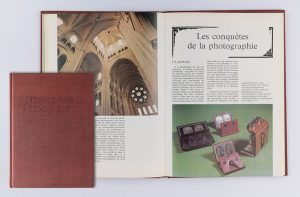Documento Mês – Fundo Bibliográfico
“Les conquêtes de la photographie: le portrait”

“Les conquêtes de la photographie: le portrait”.
Em Histoire De La Photographie, 103.
Paris: Princesse
Tinha conhecimento que a imagem estereoscópica é obtida através de uma câmara fotográfica de duas objetivas situadas a uma distância similar à que separa os olhos?
O físico inglês Charles Wheatstone (1802 – 1875) e o físico escocês David Brewster (1781 – 1868) dividem a distinção no invento do estereoscópio. Em 1838, Charles Wheatstone apresentou a invenção do visor binocular aos membros da Royal Society em Londres. Em 1849, David Brewster apresentou à Royal Scottish Society of Arts um aperfeiçoamento do estereoscópio de Wheatstone utilizando lentes prismáticas.
A fotografia estereoscópica é composta por duas imagens que mostram uma mesma cena ou objeto que, quando vistas juntas com um visor binocular (estereoscópio), produzem ao observador a ilusão de que a imagem é tridimensional. Os estereoscópicos de visor binocular ganharam uma variedade de formatos que refletiam a época e região em que foram produzidos e na sua construção são utilizadas lentes de aumento e convergência em vidro.
Did you know that a stereoscopic image is obtained by means of a camera with two lenses located at a distance similar to that between the eyes?
The English physicist Charles Wheatstone (1802 – 1875) and the Scottish physicist David Brewster (1781 – 1868) share the distinction of inventing the stereoscope. In 1838, Charles Wheatstone presented the invention of the binocular viewfinder to the members of the Royal Society in London. In 1849, David Brewster presented to the Royal Scottish Society of Arts an improvement to Wheatstone’s stereoscope using prismatic lenses.
Stereoscopic photography consists of two images showing the same scene or object that, when viewed together with a binocular viewfinder (stereoscope), give the observer the illusion that the image is three-dimensional. Binocular viewfinder stereoscopes started being manufactured in a variety of formats that reflected the time and region in which they were produced and their construction involved the use of magnifying and convergence lenses made of glass.
type due to the fragility of glass?